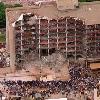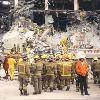

The bombed remains of automobiles with the bombed Federal Building in the background. The military is providing around the clock support since a car bomb exploded inside the building on Wednesday, April 19, 1995. (Released to Public) Tags: Oklahoma City Bombing View |
Tags: Oklahoma City Bombing, Okc Bombing View |
Tags: Oklahoma City Bombing View |
|||||||||
The Oklahoma City bombing was a bomb attack on the Alfred P. Murrah Federal Building in downtown Oklahoma City on April 19, 1995 by Timothy McVeigh, an American militia movement sympathizer who detonated an explosive-filled truck parked in front of the building. McVeighs co-conspirator, Terry Nichols, had assisted in the bomb preparation. It was the most destructive act of terrorism on American soil until the September 11, 2001 attacks (September 11 attacks). The Oklahoma blast claimed 168 lives, including 19 children under the age of 6, and injured more than 680 people. The blast destroyed or damaged 324 buildings within a sixteen-block radius, destroyed or burned 86 cars, and shattered glass in 258 nearby buildings. The bomb was estimated to have caused at least $652 million worth of damage.
Motivated by his hatred of the federal government and angered by what he perceived as its mishandling of the Waco Siege (1993) and the Ruby Ridge incident (1992), McVeigh timed his attack to coincide with the second anniversary of the deaths at Waco. Within 90 minutes of the explosion, McVeigh was stopped by Oklahoma State Trooper (Oklahoma Highway Patrol) Charlie Hanger for driving without a license plate and arrested for unlawfully carrying a weapon. Forensic evidence quickly linked McVeigh and Nichols to the attack; Nichols was arrested, and within days both were charged. Michael and Lori Fortier were later identified as accomplices. Extensive rescue efforts were undertaken by local, state, federal, and worldwide agencies in the wake of the bombing, and substantial donations were received from across the country. The Federal Emergency Management Agency (FEMA) activated eleven of its Urban Search and Rescue Task Forces (FEMA Urban Search and Rescue Task Force), consisting of 665 rescue workers who assisted in rescue and recovery operations.
The official investigation, known as "OKBOMB", was the largest criminal investigation case in American history; FBI agents conducted 28,000 interviews, amassing convert3.5STMTabbr=on of evidence, and collected nearly one billion pieces of information. The bombers were tried and convicted in 1997. McVeigh was executed by lethal injection on June 11, 2001, and Nichols was sentenced to life in prison (Life imprisonment). Michael and Lori Fortier testified against McVeigh and Nichols; Michael was sentenced to twelve years in prison for failing to warn the U.S. government, and Lori received immunity from prosecution in exchange for her testimony. As with other large-scale terrorist attacks, conspiracy theories dispute the official claims and allege the involvement of additional perpetrators.
As a result of the bombing, the U.S. government passed legislation designed to increase the protection around federal buildings (United States federal building security) to deter future terrorist attacks. From 1995 to 2005, over 60 domestic terrorism plots were foiled due to preventive measures taken in response to the bombing. On April 19, 2000, the Oklahoma City National Memorial was dedicated on the site of the Murrah Federal Building, commemorating the victims of the bombing. Annual remembrance services are held at the same time of day as the original explosion occurred.
Title: Oklahoma City bombing
Birth Location: Alfred P. Murrah Federal Building, Oklahoma City, Oklahoma, United States
Coordinates: Coord352822.4N973101Wregion:US-OK_type:landmarkdisplay=inline,title
Time: 9:02 a.m. CST
Timezone: UTC-5
Type: truck bomb
Fatalities: 168
Injuries: 680+
Perps: Timothy McVeigh, Terry Nichols
Motive: Retaliation for the Waco Siege and Ruby Ridge



